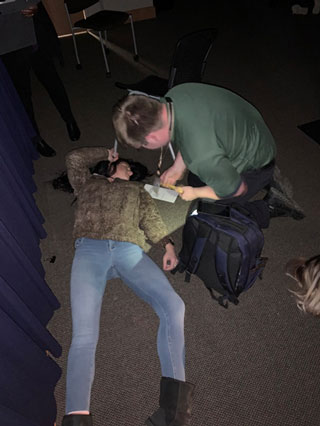Shelby County Government and Southwest Allied Health and Sciences team up for disaster drill

A certified paramedic student tags a victim as “yellow” during the mock disaster event.
The Nursing, Natural Sciences and Biotechnology Building on the Union Avenue Campus was filled with screams from wounded individuals who survived an F5 tornado Dec. 5. Others were silent, presumably dead.
Well, not exactly. The “victims,” and those who came to rescue them, were actually nursing and paramedic students who were practicing triage during an Allied Health and Sciences Department disaster simulation drill held in the building’s auditorium.
Assistant Nursing Professor and Simulation Learning Coordinator Marilyn Dillard said 43 nursing and four paramedic students took part in the drill that was designed to simulate a mass casualty event. “Everyone had cuts and bruises and various types of injuries and our nursing students had to sort the victims by their injuries and start triage,” Dillard said. “This is a very real possibility of a situation they could encounter in their jobs. So the objective was to show them the difference between how you would treat a patient in a hospital versus a disaster scene.”
Students were briefed about the Simple Triage and Rapid Treatment (START) method used in disaster scenes to quickly diagnose patients in a mass casualty environment. Those tagged as first responders had to check respiration, profusion, and mental status, and then assign a color code to patients—red for critical, yellow for those with less serious injuries, green for those who are injured, but can walk, and black for those who have died or are expected to die. “It’s different from what nurses are used to because when you start triage you don’t do a lot of patient care,” said Shermondria Ransom, medical reserve corps coordinator for the Shelby County Public Health Emergency Preparedness Program, who gave the briefing. “You have to be very fast with it because there are a lot of people injured. You have to triage in 30 seconds or less.”
During their briefing, the students were shown a video of an EF4 tornado that struck the Tuscaloosa and Birmingham, AL areas April 27, 2011, killing 64 people and injuring 1,500. The tornado’s 190 mile-per-hour winds carved a swath over a mile wide and caused $2.4 billion in damage, making it one of the costliest tornados in history. The lights in the auditorium were then turned off to simulate the disaster and first responders had to search for and triage victims using flashlights.
“It really is about just identifying who is sick and who needs help the quickest,” said Westley Jones, simulation technician in the EMT program. “This is a really good drill for the nursing students because some of them will get jobs in emergency departments and this training will help them in a real disaster event. I hope we are able to do more of these drills in the future with the nursing department.”
In This Issue...
- FROM THE PRESIDENT
- Southwest Foundation takes center stage at cityCURRENT Signature Breakfast
- Welcome aboard, new team members
- Human Resources to kick-off redesign of employee experience in 2020
- MENTAL HEALTH CORNER: Charting a new path
- HIPs teaching methods a ‘game changer’ for student success
- Project M.O.S.T. hosts “De-Stress” fest during finals
- SGA Angel Tree Program brings holiday spirit to Alton Elementary students
- FACULTY: Schedule Library Instruction session for your students today
- STUDENTS: Print 2019 Tax Forms in My.Southwest portal
- AACC names Chef Steven Leake a 2020 Dale P. Parnell Distinguished Faculty recipient
- KUDOS: Memphis Grizzlies select VP of Student Affairs Jacqueline Faulkner for annual HBCU Empowerment Award
- US Secret Service trains Southwest SERT team on workplace security
- U.S. State Department selects Dr. Christopher Hastings specialist assignment
- THEC awards Southwest and TCAT-Memphis $145K Veteran Reconnect grant
- Writers series showcases works by Southwest faculty
- Students travel to state capitol to learn law-making process
- Early FAFSA completers win book scholarships
- Culinary arts graduate opens ‘Cool Beans’ coffee shop in Cordova
- Southwest and TCAT-Memphis tout growth and expansion at 2020 Legislative Luncheon
- Southwest establishes Innovation Funds to fuel success; Now accepting grant applications
- Scholarship recipients thank Foundation donors for making dreams come true
- Southwest celebrates the holidays with faculty and staff open house
- Women of Worth accepting new members
- Shelby County Government and Southwest Allied Health and Sciences drill nursing students on disaster triage
- Business and Technologies joins National Cyber Watch Center
- SALUQI CORNER: Saluqis start new year with impressive wins
- Southwest: In the News
- 32nd Annual Carter G. Woodson Award Ceremony is Feb. 13